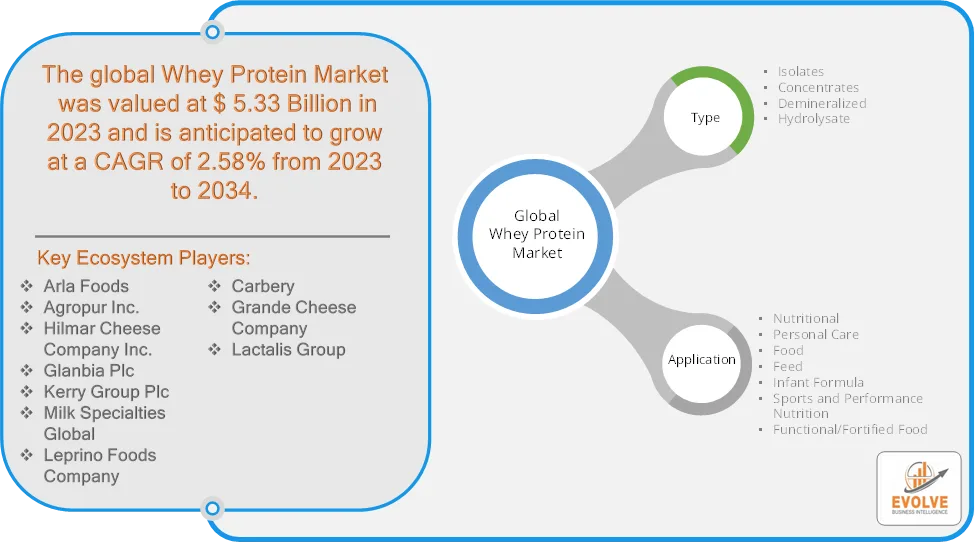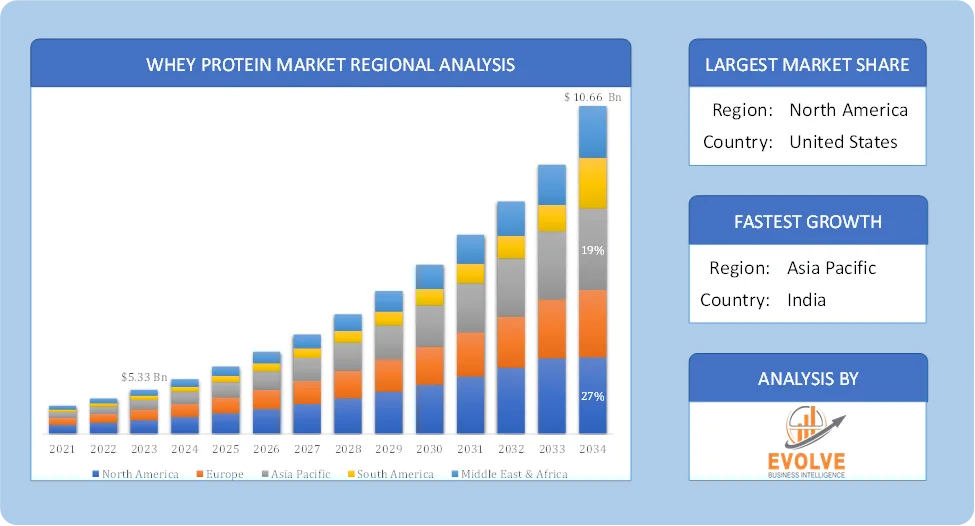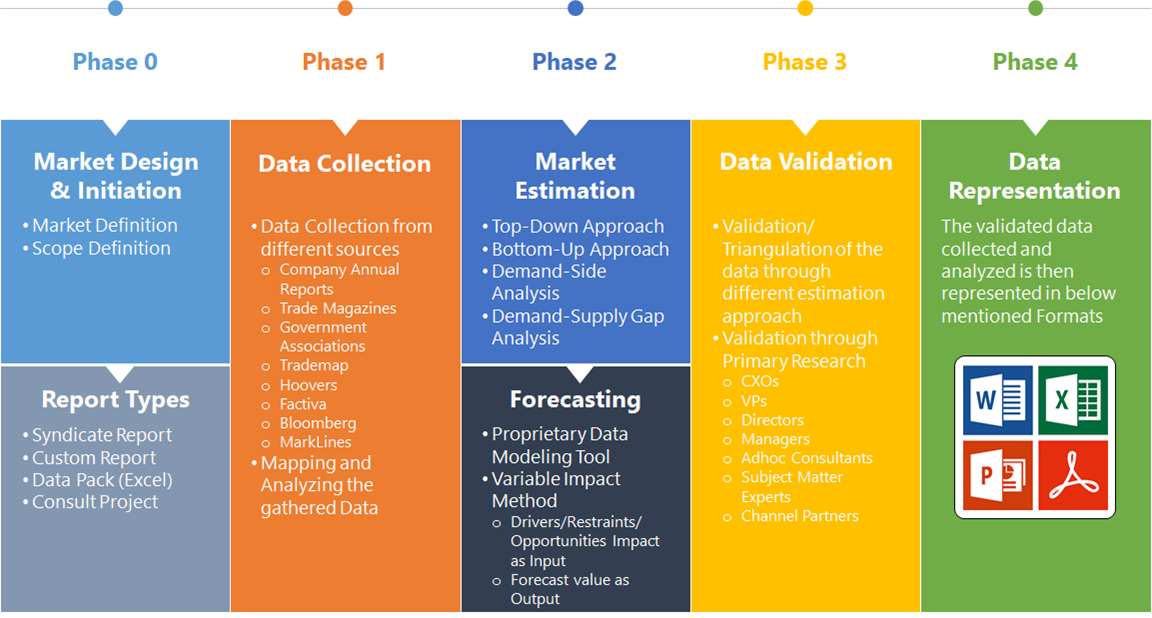Whey Protein Market Overview
The Whey Protein Market size accounted for USD 5.33 Billion in 2023 and is estimated to account for 6.85 Billion in 2024. The Market is expected to reach USD 10.66 Billion by 2034 growing at a compound annual growth rate (CAGR) of 2.58% from 2024 to 2034. The whey protein market is experiencing significant growth, driven by increasing consumer demand for high-protein diets, expanding fitness and wellness trends, and growing applications in the food, beverage, and pharmaceutical industries. Athletes and bodybuilders are primary consumers of whey protein. Elderly consumers benefit from whey protein’s role in muscle maintenance and bone health.
The whey protein market is expected to expand further due to increasing product innovations, clean-label trends, and rising applications in personalized nutrition.
Global Whey Protein Market Synopsis
 Whey Protein Market Dynamics
Whey Protein Market Dynamics
The major factors that have impacted the growth of Whey Protein Market are as follows:
Drivers:
Ø Expanding Sports Nutrition Industry
Whey protein is a key ingredient in sports and performance nutrition due to its fast absorption and muscle recovery benefits. Endorsements by athletes and fitness influencers further drive demand. Increasing use of whey protein in functional foods and beverages, such as protein bars, ready-to-drink (RTD) shakes, and dairy products and consumers seek fortified foods for improved metabolism, immunity, and digestion. Whey protein helps maintain muscle mass and bone density, reducing risks of age-related muscle loss (sarcopenia) and increased demand from elderly consumers for improved mobility and overall health.
Restraint:
- High Production Costs & Price Volatility
Whey protein production involves complex filtration and drying processes, increasing costs. Fluctuations in milk prices due to supply chain disruptions and raw material shortages affect profitability. Dairy farming, the primary source of whey, contributes to greenhouse gas emissions, water consumption, and land degradation and rising consumer preference for eco-friendly, plant-based, and sustainable protein sources.
Opportunity:
⮚ Increasing Demand for High-Protein Diets
Consumers are shifting towards high-protein, low-carb diets for weight management and muscle-building. Growing adoption of ketogenic, paleo, and high-protein meal plans boosts whey protein consumption. Whey protein is a key ingredient in infant formula, especially for lactose-reduced and hypoallergenic products. Growing applications in elderly nutrition, hospital nutrition, and dietary supplements for muscle maintenance and recovery. Growing consumer demand for non-GMO, grass-fed, hormone-free, and organic whey protein and companies investing in sustainable dairy farming and eco-friendly packaging to meet sustainability goals.
Whey Protein Market Segment Overview
Based on Type, the market is segmented based on Isolates, Concentrates, Demineralized, Hydrolysate. the concentrate segment dominant the market. These concentrates are soluble and provide minerals lactose and lipids. These concentrates have applications in dairy desserts, beverages, and yogurts due to the flavor of the product. This is a low-cost substitute used in the food industry. Protein-enriched foods and infant nutrition feed make use of the concentrates. It also finds application in the nutritional industry and meat industries.
By Application
Based on Application, the market segment has been divided into the Nutritional, Personal Care, Food, Feed, Infant Formula, Sports and Performance Nutrition, Functional/Fortified Food. Sports nutrition dominates the market. This category is popular among sportsmen and fitness enthusiasts all over the world because of the protein’s muscle-building qualities and nutritional value. The popularity of whey protein in sports nutrition stems from its ability to improve muscle repair, promote lean muscle mass development and support overall athletic performance.
Global Whey Protein Market Regional Analysis
Based on region, the global Whey Protein Market has been divided into North America, Europe, Asia-Pacific, the Middle East & Africa, and Latin America. North America is projected to dominate the use of the Whey Protein Market followed by the Asia-Pacific and Europe regions.
 North America Whey Protein Market
North America Whey Protein Market
North America holds a dominant position in the Whey Protein Market. The United States is a major contributor, driven by a strong fitness culture and high demand for protein-rich diets. It has High adoption of sports nutrition, protein-based diets, and functional foods and also has strong fitness culture and awareness of protein supplementation and expanding demand for protein-fortified foods & beverages.
Asia-Pacific Whey Protein Market
The Asia-Pacific region has indeed emerged as the fastest-growing market for the Whey Protein Market industry. Increasing health consciousness and growing middle-class population drive demand. It has rapid urbanization and rising disposable incomes, expanding fitness industry and demand for sports nutrition and high growth in infant nutrition, especially in China & India.
Competitive Landscape
The global Whey Protein Market is highly competitive, with numerous players offering a wide range of software solutions. The competitive landscape is characterized by the presence of established companies, as well as emerging startups and niche players. To increase their market position and attract a wide consumer base, the businesses are employing various strategies, such as product launches, and strategic alliances.
Prominent Players:
- Arla Foods
- Agropur Inc.
- Hilmar Cheese Company Inc.
- Glanbia Plc
- Kerry Group Plc
- Milk Specialties Global
- Leprino Foods Company
- Carbery
- Grande Cheese Company
- Lactalis Group.
Scope of the Report
Global Whey Protein Market, by Type
- Isolates
- Concentrates
- Demineralized
- Hydrolysate
Global Whey Protein Market, by Application
- Nutritional
- Personal Care
- Food
- Feed
- Infant Formula
- Sports and Performance Nutrition
- Functional/Fortified Food
Global Whey Protein Market, by Region
- North America
- US
- Canada
- Mexico
- Europe
- UK
- Germany
- France
- Italy
- Spain
- Benelux
- Nordic
- Rest of Europe
- Asia Pacific
- China
- Japan
- South Korea
- Indonesia
- Austalia
- Malaysia
- India
- Rest of Asia Pacific
- South America
- Brazil
- Argentina
- Rest of SouthAmerica
- Middle East &Africa
- Saudi Arabia
- UAE
- Egypt
- SouthAfrica
- Rest of Middle East & Africa
| Parameters | Indicators |
|---|---|
| Market Size | 2033: USD 10.66 Billion |
| CAGR (2023-2033) | 2.58% |
| Base year | 2022 |
| Forecast Period | 2023-2033 |
| Historical Data | 2021 (2017 to 2020 On Demand) |
| Report Coverage | Revenue Forecast, Competitive Landscape, Growth Factors, and Trends |
| Key Segmentations | Type, Application |
| Geographies Covered | North America, Europe, Asia-Pacific, South America, Middle East, Africa |
| Key Vendors | Arla Foods, Agropur Inc., Hilmar Cheese Company Inc., Glanbia Plc, Kerry Group Plc, Milk Specialties Global, Leprino Foods Company, Carbery, Grande Cheese Company and Lactalis Group. |
| Key Market Opportunities | · Increasing Demand for High-Protein Diets · Growth in Infant Nutrition & Medical Nutrition |
| Key Market Drivers | · Expanding Sports Nutrition Industry · Growth in Functional & Fortified Foods |
REPORT CONTENT BRIEF:
- High-level analysis of the current and future Whey Protein Market trends and opportunities
- Detailed analysis of current market drivers, restraining factors, and opportunities in the future
- Whey Protein Market historical market size for the year 2021, and forecast from 2023 to 2033
- Whey Protein Market share analysis at each product level
- Competitor analysis with detailed insight into its product segment, Government & Defense strength, and strategies adopted.
- Identifies key strategies adopted including product launches and developments, mergers and acquisitions, joint ventures, collaborations, and partnerships as well as funding taken and investment done, among others.
- To identify and understand the various factors involved in the global Whey Protein Market affected by the pandemic
- To provide a detailed insight into the major companies operating in the market. The profiling will include the Government & Defense health of the company’s past 2-3 years with segmental and regional revenue breakup, product offering, recent developments, SWOT analysis, and key strategies.








